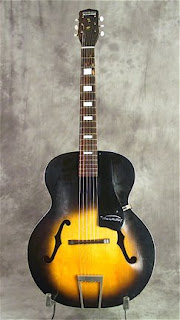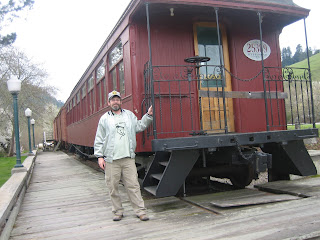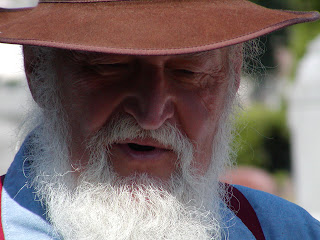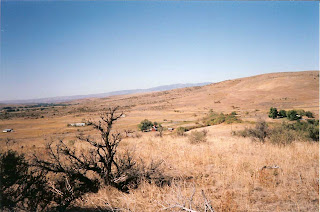
Back in the day, our area in Idaho was connected by a train line—of course, everywhere was connected by trains. The line ran from Weiser, 40 odd miles southwest of here, to New Meadows, 40 odd miles northeast. Weiser, which sits right next to the Snake River (also the Oregon border) is known for its annual fiddle festival, held every June. New Meadows isn’t known for too much—probably not well known for Meadow Valley days, held each Labor Day weekend, & which we drove through yesterday on our way to McCall. But New Meadows is the home of the last surviving Pacific & Idaho Northern Railroad Depot, which is on the National Historic Register.
Anyhoo, the local rail line was the Pacific & Idaho Northern Railroad, or the PIN as locals apparently called it. The first spike of the PIN line was driven in Weiser in 1899; the last spike was driven in New Meadows in 1911. Along the way, the line served the Seven Devils mines, the Mesa Orchards (& other local orchards, including ones in Council), & even provided transportation for the local baseball league—the so-called PIN league, founded in 1916.
The line closed in 1995—the train had already stopped going as far as New Meadows in 1979, stopping after that at Rubicon, which isn’t an incorporated town, but one of the many named “settlements” along the rail corridor. Many things associated with the PIN line are now things of the past—the Mesa Orchards, the Seven Devils mining operations, a lot of the local timber industry—& of course the PIN league. In 1997, the rail bed was deeded to the Friends of the Weiser Trail as part of the “Rails-to-Trails Conservancy.” The trail now stretches from Weiser to Rubicon, ready for hikers, bicyclists & horseback riders. It is true that the southern stretch of the trail is in the best condition; north of Council the trail is still being developed, though it’s certainly usable.
The trail didn’t come to the area without some controversy. The railroad had run its right-of-way through ranches & even backyards, & Idaho is a state where the residents have a very strong sense of personal property rights. It’s also possible that some of the actions by the folks backing the trail were perceived as high-handed or unreasonable. There were times when residents barricaded certain sections of the trail, trying to restrict access to it, & intimidating some potential users; there may also have been times when hikers haven’t been responsible about closing pasture gates; there may, too, have been times when some historic points of access for farm equipment weren’t respected. How this all shakes out I can’t say, because I only know these things by hearsay, & I also have the (probably annoying) tendency to see both sides of a story. It is true that Eberle & I avoided walking the trail for some time because the controversy seemed a bit overwhelming.
But yesterday, as a sort of early anniversary celebration, we did walk the trail in Council—not sure how far we went, but we started at the parking lot near Hornet Creek Rd & went on to mile marker 61—apparently a stop that was once used to pick up fruit from the Council orchards. The mile marker there (seen in the pic below) is interesting in that it’s fashioned from two railroad spikes.
 It was a gorgeous walk—we followed a large flock of blackbirds north up the trail. The apple trees were in fruit along the way (quite possibly seeded from apples once carried by rail from Mesa Orchards—there are lots of apple trees in this area that came from those seeds); the serviceberries were also holding their dark blue berries, & sunflowers & mulleins were in bloom. The sun was hot on what will probably be one of the last real summer days—it’s cool & drizzly this morning. We walked until we stood for a while in the shade of an old willow, looking at the old barns on both sides of the tracks, watching the blackbirds as they retreated before our approach—sometimes forming a long line across the power lines stretched over the trail. The trail is a fun walk, & for someone like me who’s no longer physically “up” to real hikes, it’s ideal, because in any given stretch there’s not much of a grade.
It was a gorgeous walk—we followed a large flock of blackbirds north up the trail. The apple trees were in fruit along the way (quite possibly seeded from apples once carried by rail from Mesa Orchards—there are lots of apple trees in this area that came from those seeds); the serviceberries were also holding their dark blue berries, & sunflowers & mulleins were in bloom. The sun was hot on what will probably be one of the last real summer days—it’s cool & drizzly this morning. We walked until we stood for a while in the shade of an old willow, looking at the old barns on both sides of the tracks, watching the blackbirds as they retreated before our approach—sometimes forming a long line across the power lines stretched over the trail. The trail is a fun walk, & for someone like me who’s no longer physically “up” to real hikes, it’s ideal, because in any given stretch there’s not much of a grade.Later as we drove toward McCall, we saw a mountain biker getting on the trail near the old Fruitvale post office, & also a couple of women hiking the more rugged stretch near Rubicon. It’s a different world now, with hikers & mountain bikes, & no trains….
If you’re interested in the Weiser River Trail, check out the following: Friends of the Weiser River Trail (this one is under construction, but has some info); Rails-To-Trails Conservancy; the Idaho Department of Fish & Game; & check out the excellent book on the PIN line, which is available through local historian Dale Fisk’s website (he also has info & mp3’s for his two bands, Hotwire & Highway 95). I got some info for this posting from the P&IN book by Dale & his co-author Don Dopf.
The photo at the top of this post was taken by Eberle Umbach.












